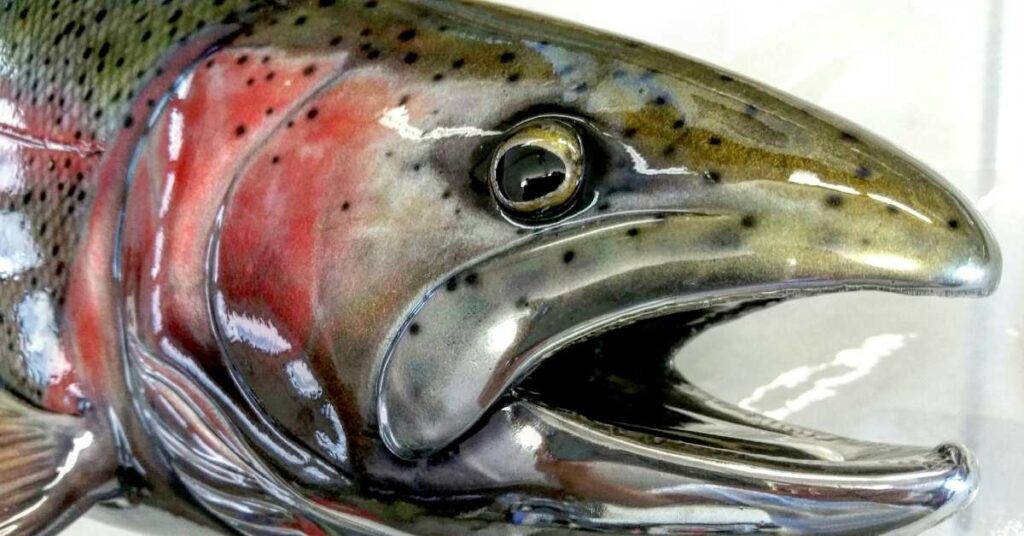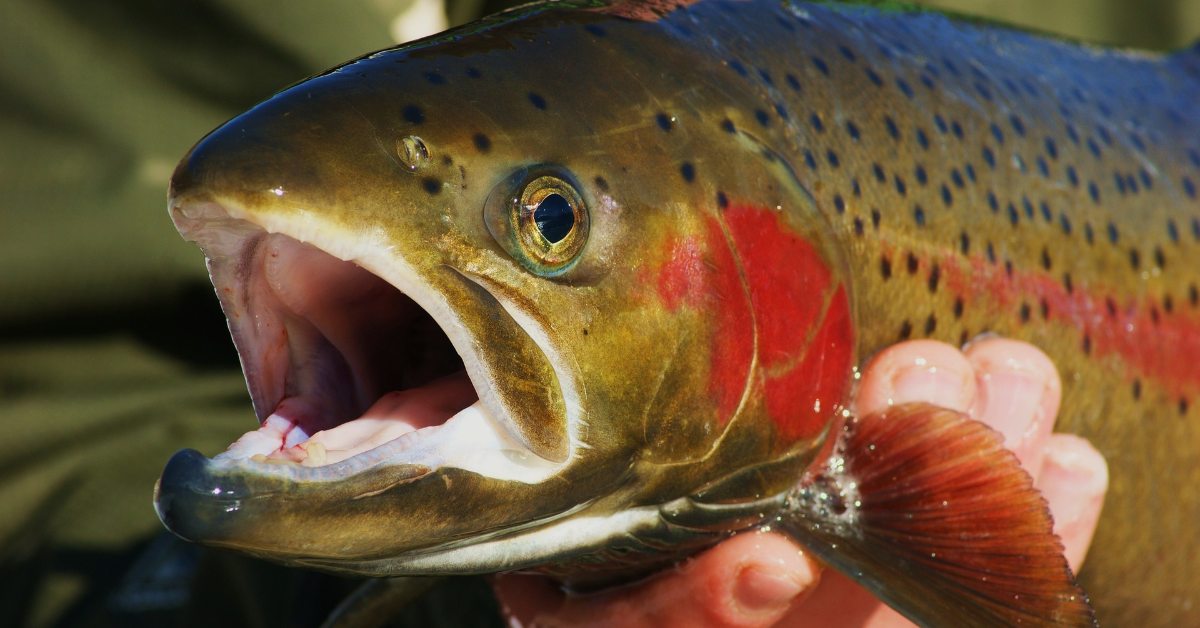Steelhead and salmon have a similar appearance at first glance. However, experienced anglers can tell you that the differences between steelhead trout vs. salmon are vast, ranging from size to taste.
Is Steelhead Salmon or Trout?
Steelhead fish is a trout, as it belongs to the rainbow trout species. However, unlike rainbow trout but like salmon, steelhead is anadromous. As a result, they can live in both freshwater and saltwater. Both steelhead and salmon move from their homes in the ocean to rivers and streams to spawn.
In fact, both Pacific salmon and steelhead share the same family and genus—Salmonidea and Oncorhynchus, respectively.
The Lifecycle of Steelhead vs Salmon
Steelhead fish spawn early in the year, between January and April, depending on the river’s level and water temperature. In contrast, salmon spawn in the fall, from September to December, according to the same water conditions that steelhead need to make their way from saltwater to freshwater.
A possible evolutionary reason why steelhead and salmon have different spawning cycles is that they could produce offspring because they’re in the same genus. However, their babies would be sterile, so having the same spawning time would work to their disadvantage.
Unlike salmon, where most species die upon spawning, steelheads largely survive the energy output to swim upriver and spawn. So, they often travel between the ocean and river many times during their lifespan to spawn. However, of the steelheads that die, the majority are male.
Characteristics of Steelhead vs Salmon
Salmon and steelhead look remarkably similar when living in the ocean. Their bodies have a silver or brilliant chrome hue, with their backs painted in a dark grey or black. Both fish also have a torpedo shape.
How to Tell a Steelhead from a Salmon
One of the most distinguishing characteristics between steelhead and salmon is the steelhead’s glistening pink stripe that runs from its gills to its sides. However, not all steelheads have this mark, so a fish without a pink line isn’t necessarily a salmon.
Another way to tell the difference between steelheads and salmon is to open their mouths. Pacific salmon have dark or black gums. In contrast, steelheads have white gums.
There’s a catch, though—Atlantic salmon have white gums. So, if you’re fishing in Atlantic salmon territory, you can’t use this feature as a differentiator.

Size of Steelhead vs Salmon
Steelhead salmon run smaller than most salmon, at 20-25 inches as adults.
So, if you catch a steelhead-looking fish that’s over 25 inches long, it’s a good indication that you’ve caught a salmon.
In contrast, it’s easy to confuse a growing salmon with a steelhead. That’s because all salmon reach at least 20 inches as adults, with most growing to 25 inches or longer. Below are the average length measurements according to salmon species.
- Pink Salmon: 20-25”
- Sockeye Salmon: 20-30”
- Coho Salmon: 25-30”
- Chum Salmon: 25-30”
- Atlantic Salmon: 25-35”
- Chinook Salmon: 30-40”
Steelhead and salmon can also differ in their weights. Adult steelheads almost always weigh less than adult salmon, at around 20 pounds. That said, some anglers report catching steelhead as large as 40 pounds, which can cause one to believe they got a salmon.
In contrast, 40 pounds is at the low end for the Atlantic and Pacific king salmon, the two largest salmon species. These fish often weigh between 40-60 pounds, with some growing up to over 80 pounds.
The remainder of the salmon species falls between steelheads and Atlantic Pacific salmon. So, more often than not, any steelhead-looking fish over 20 pounds is most likely a salmon.
Flavor Profile of Steelhead vs Salmon
When looking at steelhead fish vs. salmon, these fish have distinct but highly sought-after flavors.
Salmon has a “fishier” taste than steelhead. So, it’s an excellent option for pairing with more robust herbs and spices. Furthermore, salmon is firmer than steelhead, especially compared to the Sockeye salmon species.
In contrast, steelhead shares the lighter flavor of the trout family. It offers more tender meat than salmon and contains less fat. In fact, its flaky nature is because so little fat holds it in place, and it makes a great fish for tacos.
Needless to say, steelhead and salmon are both excellent fish to eat as stand-alone. However, it’s common to find salmon in salad and soup given that it holds up better against the melt-in-your-mouth qualities of steelhead, although you can certainly use steelhead for these dishes.

Cooking Steelhead and Salmon
Fresh steelhead and salmon have bright, beautiful flesh that ranges from pink to orange to red, depending on the species and quality of food they could access.
Although it’s easy to assume they’d need similar cooking, you need to take care when preparing steelhead; it often comes in thinner cuts than salmon, so it cooks quicker.
Nevertheless, you can replace steelhead for salmon in recipes, and vice versa.
Nutrition of Steelhead vs Salmon
Steelhead and salmon both offer an array of nutrients, especially if you eat the wild-caught instead of farm-raised varieties.
By eating steelhead, you’ll receive the following nutritional benefits from a single portion:
- Over 100% of daily vitamin D
- 58% of daily vitamin B-12
- Omega-3 fatty acids
- Selenium
- Protein
Salmon offers similar nutrition, with its main benefits for a 3.5-ounce portion as follows:
- 20% or more of daily vitamins B3, B5, B6, B12, D, and E
- 41% of daily protein
- Selenium
- Potassium
- Omega 3-fatty acids
Nevertheless, one of the most notable nutritional divergences between steelhead and salmon is the fish’s fat content. Steelhead has significantly less fat than salmon, however the omega-3 fats found in salmon are known to be protective against cardiovascular disease.
Steelhead vs Salmon Mercury
Both Steelhead Trout and Salmon are known to contain some level of mercury, which is a toxic heavy metal that can cause adverse health effects if consumed in high amounts. However, the levels of mercury in these two types of fish can vary depending on several factors.
Steelhead Trout is a type of trout that spends part of its life cycle in the ocean before returning to freshwater to spawn. Salmon, on the other hand, spend most of their lives in the ocean before returning to freshwater to spawn. Due to their different lifestyles, Steelhead Trout and Salmon can accumulate varying levels of mercury.
According to the US Environmental Protection Agency (EPA), Steelhead Trout contains an average of 0.08 parts per million (ppm) of mercury, while Salmon contains an average of 0.022 ppm of mercury. This means that Steelhead Trout tends to have higher levels of mercury compared to Salmon.
It’s important to note that the levels of mercury in fish can vary depending on the region where they were caught, their diet, and other environmental factors. So, it’s always recommended to check the latest advisory from your local health department regarding the consumption of fish and mercury levels.
Weighing Prices of Steelhead vs Salmon
If you’re on a budget and are comparing steelhead trout vs salmon for their prices, steelhead is almost always more economical.
You can expect to pay up to $20 for steelhead, whereas salmon typically starts at $20. That said, the species of salmon you purchase will impact the price. Sockeye and king salmon are usually the most expensive.
Other scenarios that affect steelhead and salmon pricing are whether they’re wild or farm-raised, the time of year, location, and demand.


Good summary, thanks.
You’re welcome!